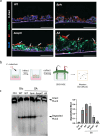Defining enteric bacterial pathogenesis using organoids: Citrobacter rodentium uses EspC, an atypical mucinolytic protease, to penetrate mouse colonic mucus
- PMID: 40323239
- PMCID: PMC12054374
- DOI: 10.1080/19490976.2025.2494717
Defining enteric bacterial pathogenesis using organoids: Citrobacter rodentium uses EspC, an atypical mucinolytic protease, to penetrate mouse colonic mucus
Abstract
Enteric bacterial pathogens pose significant threats to human health; however, the mechanisms by which they infect the mammalian gut in the face of daunting host defenses remain to be fully defined. For the attaching and effacing (A/E) bacterial family member and murine pathogen Citrobacter rodentium, its virulence strategy appears to involve penetration of the colonic mucus barrier to reach the underlying epithelium. To better define these interactions, we grew colonoids under air-liquid interface (ALI) conditions, producing a thick mucus layer that mimicked in vivo mucus composition and glycosylation. C. rodentium's penetration of ALI-derived mucus was dramatically enhanced upon exposure to sialic acid, in concert with the secretion of two serine protease autotransporter of Enterobacteriaceae (SPATE) proteins, Pic and EspC. Despite Pic being a class II SPATE, and already recognized as a mucinase, it was EspC, a class I SPATE family member, that degraded ALI-derived mucus, despite class I SPATEs not previously shown to possess mucinase activity. Confirming this finding, E. coli DH5α carrying a plasmid that expresses C. rodentium-derived EspC was able to degrade the mucus. Moreover, recombinant EspC alone also displayed mucinolytic activity in a dose-dependent manner. Collectively, our results reveal the utility of ALI-derived mucus in modeling microbe-host interactions at the intestinal mucosal surface, as well as identify EspC as an atypical class I SPATE that shows significant mucinolytic activity toward ALI-derived mucus.
Keywords: Enteric pathogens; EspC; air-liquid interface; colonoids; mucus.
Conflict of interest statement
No potential conflict of interest was reported by the author(s).
Figures






References
-
- Mundy R, Girard F, Fitzgerald AJ, Frankel G. Comparison of colonization dynamics and pathology of mice infected with enteropathogenic Escherichia coli, enterohaemorrhagic E. coli and citrobacter rodentium. FEMS Microbiol Lett. 2006;265(1):126–132. doi: 10.1111/j.1574-6968.2006.00481.x. - DOI - PubMed
-
- Deng W, Puente JL, Gruenheid S, Li Y, Vallance BA, Vázquez A, Barba J, Ibarra JA, O’Donnell P, Metalnikov P, et al. Dissecting virulence: systematic and functional analyses of a pathogenicity island. Proc Natl Acad Sci, India, Sect B Biol Sci. 2004;101(10):3597–3602. doi: 10.1073/pnas.0400326101. - DOI - PMC - PubMed
MeSH terms
Substances
LinkOut - more resources
Full Text Sources
